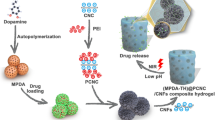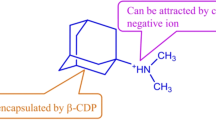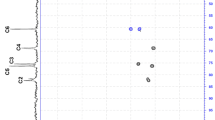Abstract
An interpenetrating double network hydrogel based on cellulose backbone and poly-dopamine dendritic structure was successfully prepared with the advantages of controlled hydrophobic drug loading, pH-responsive ability, and long-term bacteriostatic property. 13C-NMR was used to process the structural characterization and explain the mechanism of hydrogel system’s construction. Hydrophobic drug of ciprofloxacin with carbonyl group can evenly carry in the hydrogel system, and the highest loaded ratio of ciprofloxacin was reach to 80.56%. Besides, the swelling property and the controlled drug loading ability of our prepared hydrogel were carefully studied, which showed a close relation with the hydrogel design. Moreover, the in vitro drug release experiments demonstrated that the hydrogel had an obvious pH-responsive release property of ciprofloxacin, and the result of bacteriostatic experiment also showed a long-term bacteriostatic effect on Escherichia coli, which showed potential application on biological and medical fields, including wound treatment.

.











Similar content being viewed by others
References
Hoare TR, Kohane DS (2008) Hydrogels in drug delivery: progress and challenges. Polymer 49:1993–2007. https://doi.org/10.1016/j.polymer.2008.01.027
Hoffman AS (2012) Hydrogels for biomedical applications. Adv Drug Deliver Rev 64:18–23. https://doi.org/10.1016/j.addr.2012.09.010
Singh NK, Lee DS (2014) In situ gelling pH- and temperature-sensitive biodegradable block copolymer hydrogels for drug delivery. J Control Release 193:214–227. https://doi.org/10.1016/j.jconrel.2014.04.056
Larrañeta E, Stewart S, Ervine M et al (2018) Hydrogels for hydrophobic drug delivery. Classification, synthesis and applications. J Func Biomater 9. https://doi.org/10.3390/jfb9010013
Bedian L, Villalba-Rodríguez AM, Hernández-Vargas G et al (2017) Bio-based materials with novel characteristics for tissue engineering applications—a review. Int J Biol Macromol 98:837–846. https://doi.org/10.1016/j.ijbiomac.2017.02.048
Li YY, Wang B, Ma MG, Wang B (2018) Review of recent development on preparation, properties, and applications of cellulose-based functional materials. Int J Polym Sci 2018:1–18. https://doi.org/10.1155/2018/8973643
Hubbe MA, Ayoub A, Daystar JS et al (2013) Enhanced absorbent products incorporating cellulose and its derivatives: a review. BioResources 8:6556–6629. https://doi.org/10.15376/biores.8.4.6556-6629
Heinze T, Koschella A (2005) Carboxymethyl ethers of cellulose and starch—a review. Macromol Symp 223:13–39. https://doi.org/10.1002/masy.200550502
Chang CY, Zhang LN (2011) Cellulose-based hydrogels: present status and application prospects. Carbohyd Polym 84:40–53. https://doi.org/10.1016/j.carbpol.2010.12.023
Chang CY, Duan B, Cai J et al (2010) Superabsorbent hydrogels based on cellulose for smart swelling and controllable delivery. Eur Polym J 46:92–100. https://doi.org/10.1016/j.eurpolymj.2009.04.033
Sannino A, Demitri C, Madaghiele M (2009) Biodegradable cellulose-based hydrogels: design and applications. Materials 2:353–373. https://doi.org/10.3390/ma2020353
Li YT, Lokitz BS, Armes SP et al (2006) Synthesis of reversible shell cross-linked micelles for controlled release of bioactive agents. Macromolecules 39:2726–2728. https://doi.org/10.1021/ma0604035
Bordes R, van de Ven TGM (2017) Nanocellulose: what used to be cellulose micelles. Curr Opin Colloid 29:A1–A2. https://doi.org/10.1016/j.cocis.2017.05.004
Munoz SZ, Zhadan R, Acosta E (2017) Design of nonionic micelle-laden polysaccharide hydrogels for controlled delivery of hydrophobic drugs. Int J Pharmaceut 526:455–465. https://doi.org/10.1016/j.ijpharm.2017.04.062
Himmelein S, Lewe V, Stuart MCA et al (2014) A carbohydrate-based hydrogel containing vesicles as responsive non-covalent cross-linkers. Chem Sci 5:1054–1058. https://doi.org/10.1039/c3sc52964a
Laurén P, Lou YR, Raki M et al (2014) Technetium-99m-labeled nanofibrillar cellulose hydrogel for in vivo drug release. Eur J Pharm Sci 65:79–88. https://doi.org/10.1016/j.ejps.2014.09.013
Paukkonen H, Kunnari M, Laurén P et al (2017) Nanofibrillar cellulose hydrogels and reconstructed hydrogels as matrices for controlled drug release. Int J Pharmaceut 532:269–280. https://doi.org/10.1016/j.ijpharm.2017.09.002
Sellergren B, Allender CJ (2005) Molecularly imprinted polymers: a bridge to advanced drug delivery. Adv Drug Deliver Rev 57:1733–1741. https://doi.org/10.1016/j.addr.2005.07.010
Alvarez-Lorenzo C, Concheiro A (2004) Molecularly imprinted polymers for drug delivery. J Chromatogr B 804:231–245. https://doi.org/10.1016/j.jchromb.2003.12.032
Ochs CJ, Hong T, Such GK et al (2011) Dopamine-mediated continuous assembly of biodegradable capsules. Chem Mater 23:3141–3143. https://doi.org/10.1021/cm201390e
Kaminska I, Das MR, Coffinier Y et al (2012) Reduction and functionalization of graphene oxide sheets using biomimetic dopamine derivatives in one step. Acs Appl Mater Inter 4:1016–1020. https://doi.org/10.1021/am201664n
Wen Q, Liu L, Yang Q et al (2013) Dopamine-modified cationic conjugated polymer as a new platform for pH sensing and autophagy imaging. Adv Funct Mater 23:764–769. https://doi.org/10.1002/adfm.201202132
Liu Y, Ai K, Lu L (2014) Polydopamine and its derivative materials: synthesis and promising applications in energy, environmental, and biomedical fields. Chem Rev 114:5057–5115. https://doi.org/10.1021/cr400407a
Dreyer DR, Miller DJ, Freeman BD et al (2013) Perspectives on poly(dopamine). Chem Sci 4:3796–3802. https://doi.org/10.1039/c3sc51501j
Liu M, Zeng G, Wang K et al (2016) Recent developments in polydopamine: an emerging soft matter for surface modification and biomedical applications. Nanoscale 8:16819–16840. https://doi.org/10.1039/C5NR09078D
Han L, Lu X, Liu K et al (2017) Mussel-inspired adhesive and tough hydrogel based on nanoclay confined dopamine polymerization. ACS Nano 11:2561–2574. https://doi.org/10.1021/acsnano.6b05318
Li L, Yan B, Yang J et al (2015) Novel mussel-inspired injectable self-healing hydrogel with anti-biofouling property. Adv Mater 27:1294–1299. https://doi.org/10.1002/adma.201405166
Han L, Lu X, Wang M, Gan D, Deng W, Wang K, Fang L, Liu K, Chan CW, Tang Y, Weng LT, Yuan H (2017) A mussel-inspired conductive, self-adhesive, and self-healable tough hydrogel as cell stimulators and implantable bioelectronics. Small 13. https://doi.org/10.1002/smll.201601916
Wu ZR, Zheng LF, Li Y et al (2012) Synthesis and structure–activity relationships and effects of phenylpropanoid amides of octopamine and dopamine on tyrosinase inhibition and antioxidation. Food Chem 134:1128–1131. https://doi.org/10.1016/j.foodchem.2012.02.152
Sun PY, Tian LY, Zheng Z et al (2009) Dopamine-containing mussel mimetic polyurethane. Acta Polym Sin 8:803–808. https://doi.org/10.3724/sp.j.1105.2009.00803
Bezuglov V, Bobrov M, Gretskaya N et al (2001) Synthesis and biological evaluation of novel amides of polyunsaturated fatty acids with dopamine. Bioorg Med Chem Lett 11:447–449. https://doi.org/10.1016/s0960-894x(00)00689-2
Ernst J, Klinger-Strobel M, Arnold K et al (2018) Polyester-based particles to overcome the obstacles of mucus and biofilms in the lung for tobramycin application under static and dynamic fluidic conditions. Eur J Pharm Biopharm 131:120–129. https://doi.org/10.1016/j.ejpb.2018.07.025
Lane DD, Fessler AK, Goo S et al (2017) Sustained tobramycin release from polyphosphate double network hydrogels. Acta Biomater 50:484–492. https://doi.org/10.1016/j.actbio.2016.12.030
Kono H, Oshima K, Hashimoto H et al (2016) NMR characterization of sodium carboxymethyl cellulose: substituent distribution and mole fraction of monomers in the polymer chains. Carbohyd Polym 146:1–9. https://doi.org/10.1016/j.carbpol.2016.03.021
Kono H, Oshima K, Hashimoto H et al (2016) NMR characterization of sodium carboxymethyl cellulose 2: chemical shift assignment and conformation analysis of substituent groups. Carbohyd Polym 150:241–249. https://doi.org/10.1016/j.carbpol.2016.05.003
Follain N, Montanari S, Jeacomine I, Gambarelli S, Vignon MR (2008) Coupling of amines with polyglucuronic acid: evidence for amide bond formation. Carbohyd Polym 74:333–343. https://doi.org/10.1016/j.carbpol.2008.02.016
Toffey A, Samaranayake G, Frazier CE, Glasser WG (1996) Chitin derivatives. I. Kinetics of the heat-induced conversion of chitosan to chitin. J Appl Polym Sci 60:75–85. https://doi.org/10.1002/(SICI)1097-4628(19960404)60:1<75::AID-APP9>3.0.CO;2-S
Zieba A, Maslankiewicz A, Sitkowski J (2004) Spectral assignments and reference data - H-1, C-13 and N-15 NMR spectra of ciprofloxacin. Magn Reson Chem 42:903–904. https://doi.org/10.1002/mrc.1468
Kang X, Cai W, Zhang S et al (2017) Revealing the formation mechanism of insoluble polydopamine by using a simplified model system. Polym Chem 8:860–864. https://doi.org/10.1039/C6PY02005D
Cheon JY, Park WH (2016) Effect of solution pH on the self-polymerization behavior of 3,4-Dihydroxyphenylalanine. Macromol Res 10:940–942. https://doi.org/10.1007/s13233-016-4133-2
Chen CT, Martin-Martinez FJ, Jung GS et al (2017) Polydopamine and eumelanin molecular structures investigated with ab initio calculations. Chem Sci 8:1631–1641. https://doi.org/10.1039/c6sc04692d
Chen Z, Wang T, Yan X (2017) Synthesis of an elastic beta-cyclodextrin hydrogel cage by hydroxyethyl cellulose. J Appl Polym Sci 2:44388. https://doi.org/10.1002/app.44388
Chen Z, Wang T, Yan Q (2018) Building a polysaccharide hydrogel capsule delivery system for control release of ibuprofen. J Biomat Sci Polym E 29:309–324. https://doi.org/10.1080/09205063.2017.1415583
Herlinger E, Jameson RF, Linert W (1995) Spontaneous autoxidation of dopamine. J Chem SocPerkin Trans 2:259–263. https://doi.org/10.1039/P29950000259
Xuan Y, Jiang GC, Li YY et al (2013) Inhibiting effect of dopamine adsorption and polymerization on hydrated swelling of montmorillonite. Colloid Surface A 422:50–60. https://doi.org/10.1016/j.colsurfa.2013.01.038
Cox RA (2005) A comparison of the mechanisms of hydrolysis of benzimidates, esters, and amides in sulfuric acid media. Can J Chem 83:1391–1399. https://doi.org/10.1139/v05-142
Kono H, Zakimi M (2013) Preparation, water absorbency, and enzyme degradability of novel chitin- and cellulose/chitin-based superabsorbent hydrogels. J Appl Polym Sci 128:572–581. https://doi.org/10.1002/app.38217
Elliott JE, Macdonald M, Nie J et al (2004) Structure and swelling of poly (acrylic acid) hydrogels: effect of pH, ionic strength, and dilution on the crosslinked polymer structure. Polymer 45:1503–1510. https://doi.org/10.1016/j.polymer.2003.12.040
Guo B, Yuan J, Yao L et al (2007) Preparation and release profiles of pH/temperature-responsive carboxymethyl chitosan/P(2-(dimethylamino) ethyl methacrylate) semi-IPN amphoteric hydrogel. Colloid Polym Sci 285:665–671. https://doi.org/10.1007/s00396-006-1611-7
Doi M, Matsumoto M, Hirose Y (1992) Deformation of ionic polymer gels by electric fields. Macromolecules 25:5504–5511. https://doi.org/10.1021/ma00046a058
Dreyer DR, Miller DJ, Freeman BD et al (2012) Elucidating the structure of poly(dopamine). Langmuir 28:6428–6435. https://doi.org/10.1021/la204831b
Wang Q, Li S, Wang Z et al (2009) Preparation and characterization of a positive thermoresponsive hydrogel for drug loading and release. J Appl Polym Sci 111:1417–1425. https://doi.org/10.1002/app.29026
Ma Z, Jia X, Hu J et al (2013) Mussel-inspired thermosensitive polydopamine-graft-poly(N-isopropylacrylamide) coating for controlled-release fertilizer. J Agr Food Chem 61:12232–12237. https://doi.org/10.1021/jf4038826
Ma Z, Jia X, Zhang GX et al (2013) pH-responsive controlled-release fertilizer with water retention via atom transfer radical polymerization of acrylic acid on mussel-inspired initiator. J Agr Food Chem 61:5474–5482. https://doi.org/10.1021/jf401102a
Wang C, Yan Q, Liu HB et al (2011) Different EDC/NHS activation mechanisms between PAA and PMAA brushes and the following amidation reactions. Langmuir 27:12058–12068. https://doi.org/10.1021/la202267p
Surber C, Abels C, Maibach H (eds) (2018) pH of the skin: issues and challenges. Curr Probl Dermatol. Basel, Karger, vol 54, pp 19–25. https://doi.org/10.1159/000489514
Mercier RC, Stumpo C, Rybak MJ (2002) Effect of growth phase and pH on the in vitro activity of a new glycopeptide, oritavancin (LY333328), against Staphylococcus aureus and Enterococcus faecium. J Antimicrob Chemoth 50:19–24. https://doi.org/10.1093/jac/dkf058
Sjollema J, Zaat SAJ, Fontaine V et al (2018) In vitro methods for the evaluation of antimicrobial surface designs. Acta Biomaterialia 70:12–24. https://doi.org/10.1016/j.actbio.2018.02.001
Agnihotri S, Mukherji S, Mukherji S (2012) Antimicrobial chitosan-PVA hydrogel as a nanoreactor and immobilizing matrix for silver nanoparticles. Appl Nanosci 2:179–188. https://doi.org/10.1007/s13204-012-0080-1
Pathania D, Verma C, Negi P et al (2018) Novel nanohydrogel based on itaconic acid grafted tragacanth gum for controlled release of ampicillin. Carbohyd Polym 196:262–271. https://doi.org/10.1016/j.carbpol.2018.05.040
Guan Y, Chen J, Qi X et al (2015) Fabrication of biopolymer hydrogel containing Ag nanoparticles for antibacterial property. Ind Eng Chem Res 54:7393–7400. https://doi.org/10.1021/acs.iecr.5b01532
Tevyashova A, Sztaricskai F, Batta G et al (2004) Formation of squaric acid amides of anthracycline antibiotics. Synthesis and cytotoxic properties. Bioorg Med Chem Lett 14:4783–4789. https://doi.org/10.1016/j.bmcl.2004.06.072
Chen MH, Lu DW, Zhang X et al (2017) Synthesis of novel coumarin substituted amide derivatives and their antibacterial activities. Chem Pap 71:1579–1586. https://doi.org/10.1007/s11696-017-0149-0
Funding
The authors thank the Natural Science Foundation of Heilongjiang Province of China (E2018002), the National Natural Science Foundation of China (51403030), and the University-Student Innovative Experiment Project Fund Support for Northeast Forestry University (No. 201710225277).
Author information
Authors and Affiliations
Corresponding author
Ethics declarations
Conflict of interest
The authors declare that they have no conflict of interest.
Additional information
Publisher’s note
Springer Nature remains neutral with regard to jurisdictional claims in published maps and institutional affiliations.
Rights and permissions
About this article
Cite this article
Yan, Q., Liu, L., Wang, T. et al. A pH-responsive hydrogel system based on cellulose and dopamine with controlled hydrophobic drug delivery ability and long-term bacteriostatic property. Colloid Polym Sci 297, 705–717 (2019). https://doi.org/10.1007/s00396-019-04501-w
Received:
Revised:
Accepted:
Published:
Issue Date:
DOI: https://doi.org/10.1007/s00396-019-04501-w




